Nickname(s) "White Feather" Name Carlos Hathcock Years of service 1959–1979 | Unit 1st Marine Division | |
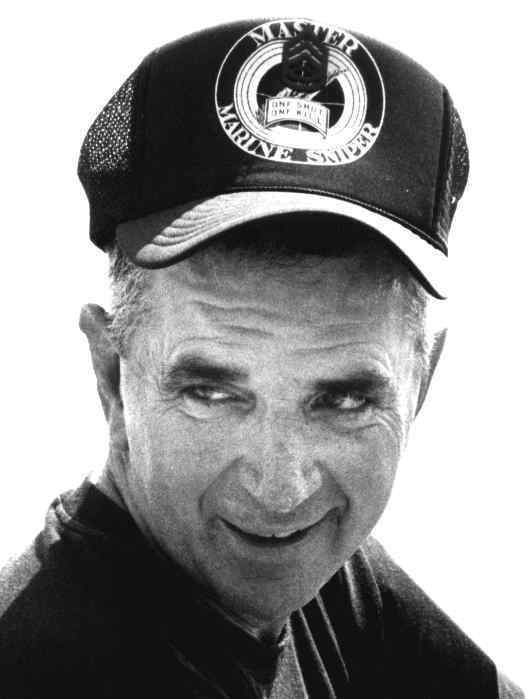 | ||
Allegiance United States of America Parents Carlos Hathcock, Agnes Hathcock Similar People Died February 23, 1999 (aged 56) Virginia Beach, Virginia, U.S. | ||
Carlos hathcock
Carlos Norman Hathcock II (May 20, 1942 – February 22, 1999) was a United States Marine Corps (USMC) sniper with a service record of 93 confirmed kills. Hathcock's record and the extraordinary details of the missions he undertook made him a legend in the U.S. Marine Corps. He was honored by having a rifle named after him: a variant of the M21 dubbed the Springfield Armory M25 White Feather, for the nickname "White Feather" given to Hathcock by the North Vietnamese Army (NVA).
Contents
- Carlos hathcock
- Carlos hathcock the u s marine sniper
- Early life and education
- Career
- Confirmed kills
- Confrontations with North Vietnamese snipers
- Medical evacuation
- After the Vietnam War
- Later life and death
- Awards and decorations
- Legacy
- Books
- Weaponry
- In popular culture
- Film
- Literature
- Television
- References
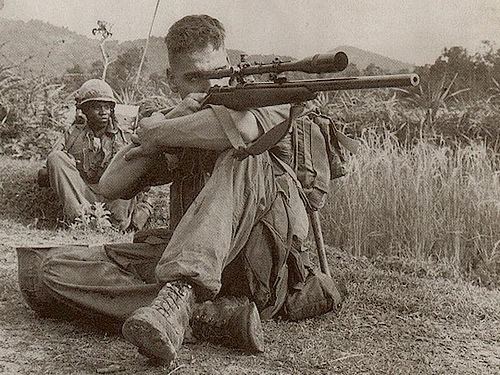
Carlos hathcock the u s marine sniper
Early life and education
Hathcock was born in Little Rock, Arkansas on May 20, 1942. He grew up in rural Arkansas, living with his grandmother after his parents separated. While visiting relatives in Mississippi, he took to shooting and hunting at an early age, partly out of necessity to help feed his poor family. He would go into the woods with his dog and pretend to be a soldier and hunt imaginary Japanese with the old Mauser his father brought back from World War ll. He hunted at that early age with a .22-caliber J. C. Higgins single-shot rifle. Hathcock dreamed of being a Marine throughout his childhood, and so on May 20, 1959, at the age of 17, he enlisted in the U.S. Marine Corps. Hathcock married Jo Winstead on the date of the Marine Corps birthday, on November 10, 1962. Jo gave birth to a son, whom they named Carlos Norman Hathcock III.
Career
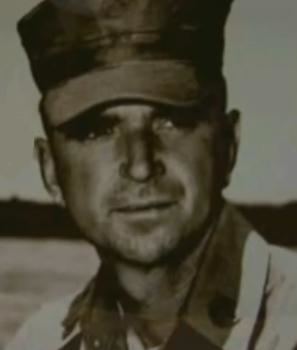
Before deploying to Vietnam, Hathcock had won shooting championships, including matches at Camp Perry and the Wimbledon Cup. In 1966, Hathcock started his deployment in Vietnam as a military policeman and later became a Sniper after Captain Edward James Land pushed the Marines into raising snipers in every platoon. Land later recruited Marines who had set their own records in sharpshooting; he quickly found Hathcock, who had won the Wimbledon Cup, the most prestigious prize for long-range shooting, at Camp Perry in 1965.
Confirmed kills
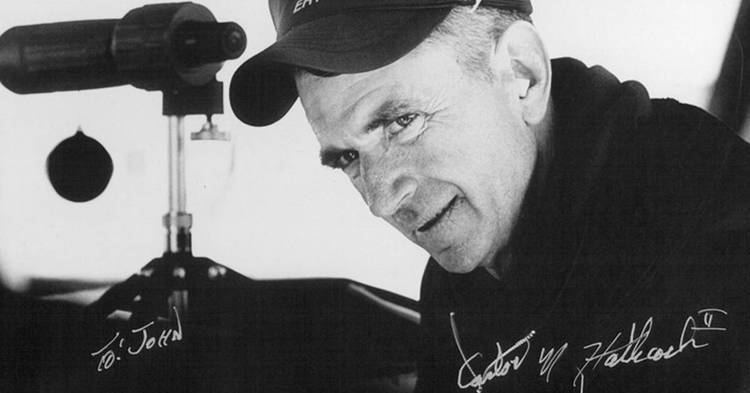
During the Vietnam War, Hathcock had 93 confirmed kills of North Vietnamese Army and Viet Cong personnel. In the Vietnam War, kills had to be confirmed by an acting third party, who had to be an officer, besides the sniper's spotter. Snipers often did not have an acting third party present, making confirmation difficult, especially if the target was behind enemy lines, as was usually the case.
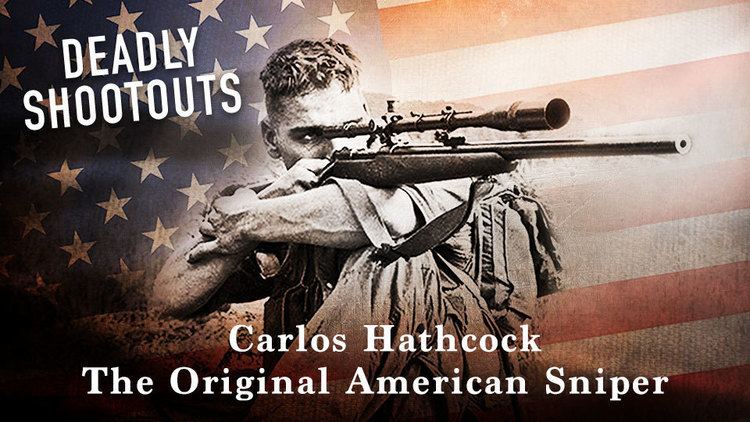
Hathcock estimated that he had killed between 300 and 400 enemy personnel during his time in Vietnam.
Confrontations with North Vietnamese snipers
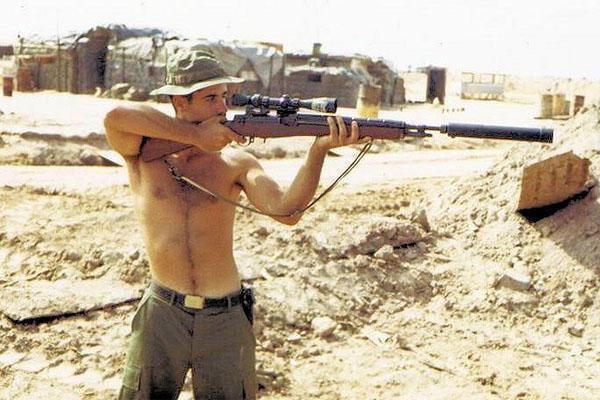
The North Vietnamese Army placed a bounty of US$30,000 on Hathcock's life for killing so many of their men. Rewards put on U.S. snipers by the NVA typically ranged from $8 to $2,000. Hathcock held the record for highest bounty and killed every known Vietnamese marksman who sought him to collect it. The Viet Cong and NVA called Hathcock Du kích Lông Trắng, translated as "White Feather Sniper", because of the white feather he kept in a band on his bush hat. After a platoon of Vietnamese snipers was sent to hunt down "White Feather", many Marines in the same area donned white feathers to deceive the enemy. These Marines were aware of the impact Hathcock's death would have and took it upon themselves to make themselves targets in order to confuse the counter-snipers.
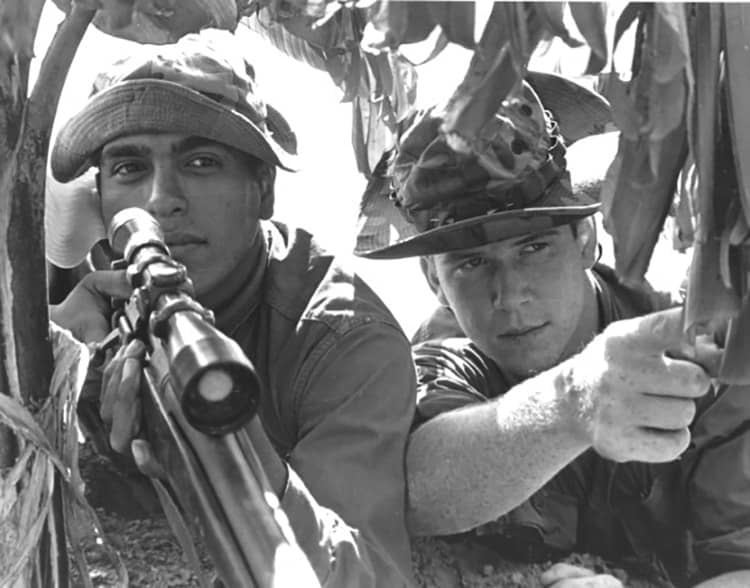
One of Hathcock's most famous accomplishments was shooting an enemy sniper through the enemy's own rifle scope, hitting him in the eye and killing him. Hathcock and John Roland Burke, his spotter, were stalking the enemy sniper in the jungle near Hill 55, the firebase from which Hathcock was operating, southwest of Da Nang. The sniper, known only as the "Cobra," had already killed several Marines and was believed to have been sent specifically to kill Hathcock. When Hathcock saw a flash of light (light reflecting off the enemy sniper's scope) in the bushes, he fired at it, shooting through the scope and killing the sniper. Surveying the situation, Hathcock concluded that the only feasible way he could have put the bullet straight down the enemy's scope, through his eye, would have been if both snipers were zeroing in on each other at the same time, which gave him only a few seconds to act, and Hathcock fired first. Given the flight time of rounds at long ranges, the snipers could have simultaneously killed one another. Hathcock took possession of the dead sniper's rifle, hoping to bring it home as a "trophy", but after he turned it in and tagged it, it was stolen from the armory.
A female Viet Cong sniper, platoon commander, and interrogator known as "Apache" because of her methods of torturing U.S. Marines and South Vietnamese Army (SVA/ARVN) troops and letting them bleed to death, was killed by Hathcock. This was a major morale victory as "Apache" was terrorizing the troops around Hill 55.
Hathcock only once removed the white feather from his bush hat while deployed in Vietnam. During a volunteer mission days before the end of his first deployment, he crawled over 1,500 yards of field to shoot a high-ranking NVA officer. He was not informed of the details of the mission until he accepted it. This effort took four days and three nights, without sleep, of constant inch-by-inch crawling. Hathcock said he was almost stepped on as he lay camouflaged with grass and vegetation in a meadow shortly after sunset. At one point he was nearly bitten by a bamboo viper, but had the presence of mind to avoid moving and giving up his position. As the officer exited his encampment, Hathcock fired a single shot that struck the officer in the chest, killing him.
After the arduous mission of killing the NVA officer, Hathcock returned to the United States in 1967. He missed the Marine Corps, however, and returned to Vietnam in 1969, where he took command of a platoon of snipers.
Medical evacuation
On September 16, 1969, Hathcock's career as a sniper came to a sudden end along Route 1, north of LZ Baldy, when an AMTRAC he was riding on, an LVT-5, struck an anti-tank mine. Hathcock pulled seven Marines from the flame-engulfed vehicle, suffering severe burns (some were third-degree) to his face, arms and legs, before jumping to safety. While recovering, Hathcock received the Purple Heart. Nearly 30 years later, he received a Silver Star for this action. All eight injured Marines were evacuated by helicopter to hospital ship USS Repose (AH-16), then to a Naval Hospital in Tokyo, and ultimately to the burn center at Brooke Army Medical Center in San Antonio, Texas.
After the Vietnam War
After returning to active duty, Hathcock helped establish the Marine Corps Scout Sniper School, at the Marine base in Quantico, Virginia. Due to his extreme injuries suffered in Vietnam, he was in nearly constant pain, but he continued to dedicate himself to teaching snipers. In 1975, Hathcock's health began to deteriorate, and he was diagnosed with multiple sclerosis. He stayed in the Marine Corps, but his health continued to decline. And, just 55 days short of the 20 years that would have made him eligible for regular retirement pay, he received a permanent disability separation. Being medically discharged, he received 100 percent disability pay. He would have received only 50 percent of his final pay grade had he retired after 20 years. He fell into a state of depression when he was forced out of the Marines, because he felt as if the service had kicked him out. During this depression, his wife Jo nearly left him but decided to stay. Hathcock eventually picked up the hobby of shark fishing, which helped him overcome his depression.
Hathcock provided sniper instruction to police departments and select military units, such as SEAL Team Six.
Later life and death
Hathcock once said that he survived in his work because of an ability to "get in the bubble", to put himself into a state of "utter, complete, absolute concentration", first with his equipment, then his environment, in which every breeze and every leaf meant something, and finally on his quarry. After the war, a friend showed Hathcock a passage written by Ernest Hemingway: "Certainly there is no hunting like the hunting of man, and those who have hunted armed men long enough and like it, never really care for anything else thereafter." He copied Hemingway's words on a piece of paper. "He got that right," Hathcock said. "It was the hunt, not the killing." Hathcock said in a book written about his career as a sniper: "I like shooting, and I love hunting. But I never did enjoy killing anybody. It's my job. If I don't get those bastards, then they're gonna kill a lot of these kids dressed up like Marines. That's the way I look at it."
Hathcock's son, Carlos Hathcock III, later enlisted in the U.S. Marine Corps; he retired from the Marine Corps as a Gunnery Sergeant after following in his father's footsteps as a Shooter and became a member of the Board of Governors of the Marine Corps Distinguished Shooters Association.
Hathcock died on February 22, 1999, in Virginia Beach, Virginia, from complications resulting from multiple sclerosis.
Awards and decorations
Legacy
Hathcock remains a legend in the U.S. Marine Corps. The Gunnery Sergeant Carlos Hathcock Award is presented annually by the National Defense Industrial Association "to recognize an individual who ... has made significant contributions in operational employment and tactics of small arms weapons systems which have impacted the readiness and capabilities of the U.S. military or law enforcement." The Marine Corps League (MCL) sponsors an annual program with 12 award categories, which includes the Gunnery Sergeant Carlos N. Hathcock II Award presented "to an enlisted Marine who has made an outstanding contribution to the improvement of marksmanship training." A sniper range named for Hathcock is at Camp Lejeune, North Carolina.
In 1967, Hathcock set the record for the longest sniper kill. He used an M2 .50 Cal Browning machine gun mounted with a telescopic sight at a range of 2,500 yd (2,286 m), killing a Vietcong guerrilla. In 2002, this record was broken by Canadian snipers (Rob Furlong and Arron Perry) from the third battalion of Princess Patricia's Canadian Light Infantry during the War in Afghanistan. Hathcock was one of several individuals to utilize the M2 Browning machine gun in the sniping role. This success led to the adoption of the .50 BMG cartridge as a viable sniper round. Sniper rifles have since been designed around and chambered in this caliber since the 1970s. Rob Furlong held the record of longest kill shot recorded in history until November 2009, when his record of 2,430 m (2,657 yd) was beaten by British CoH (Corporal of Horse) of the Household Cavalry of the British Army Craig Harrison, who set a new record by shooting two Taliban fighters at 2,475 m (2,707 yd).
Springfield Armory designed a highly accurized version of their M1A Supermatch rifle with a McMillan Stock and match grade barrel and dubbed it the "M-25 White Feather". The rifle had a likeness of Hathcock's signature and his "white feather logo" marked on the receiver.
Turner Saddlery similarly honored Hathcock by producing a line of leather rifle slings based on his design. The slings are embossed with Hathcock's signature.
On March 9, 2007, the rifle and pistol complex at Marine Corps Air Station Miramar was officially renamed the Carlos Hathcock Range Complex.
Books
Hathcock is the subject of a number of books including:
Weaponry
Hathcock generally used the standard sniper rifle: the Winchester Model 70 .30-06 caliber rifle with the standard 8-power Unertl scope. On some occasions, however, he used a different weapon: the M2 Browning machine gun, on which he mounted a 10X Unertl scope, using a bracket of his own design. Hathcock made a number of kills with this weapon in excess of 1,000 yards, including his record for the longest confirmed kill at 2,500 yards (since surpassed). Hathcock carried a Colt M1911A1 pistol as a sidearm.
In popular culture
Hathcock's career as a sniper has been used as a basis for a variety of fictional snipers, from the "shooting through the scope incident" to the number of kills he made.
